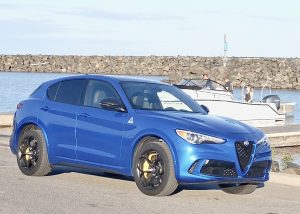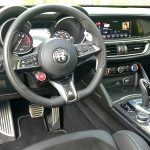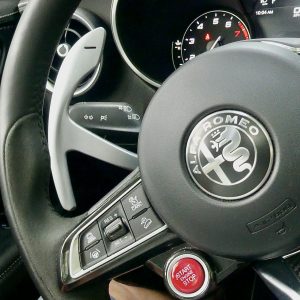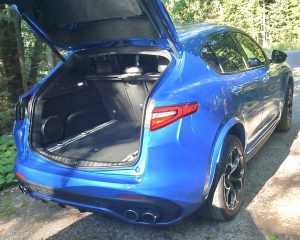Alfa gives Stelvio a little dose of Formula 1 spirit
By John Gilbert
If you owned an Alfa Romeo Stelvio, there would be several ways to point out that you are supremely lucky.
That’s the first indication, because you’re lucky enough to be driving this specialty SUV, which is one of the best-driving and most satisfying vehicles — cars, sports cars, trucks or SUVs — in the world.
Another good luck symbol is the neat little 4-leaf clover emblazoned on the flanks. That stands for Quadrifoglio, which means it is the hot one of the bunch, with all-wheel drive and perhaps the most sophisticated engine put under the hood of any production vehicle.
A third indication of your good fortune is that you might have accumulated a good fortune, in business or whatever your job might be, because you’ve made enough money to be able to afford the sticker price on the Alfa Romeo Stelvio — a cool $96,540 for my week-long test-drive Stelvio.
No, you don’t have to spend that much on the high-end Stelvio. which comes for far less with the base engine, but if you’ve got it, what could be more fun than to spend a chunk of it to get such a vehicle equipped with the 2.9-liter V6 designed and hand-built by Ferrari’s Formula 1 engineers? Think about all the overpowered sporty cars and trucks that have engines up and over 6 liters in displacement just to get enough power to satisfy their buyers. Yet, with the right technology, and engineering brilliance, the comparatively tiny 2.9 liters of displacement can be designed and perfected to produce 505 horsepower and 443 foot-pounds of torque.
Your neighborhood hot-rodder might be able to tweak any engine into providing extra power, but this is a whole ‘nother plateau. With all the trick parts at their disposal, the same engineering staff that puts the engines in the Formula 1 race cars driven by Sebastian Vettel and Charles Leclerc on satellite TV most early Sunday mornings was given a challenge by the late and charismatic leader, Sergio Marchione. As the head man at Fiat, and thus Fiat Chrysler Automobiles, Marchione had orchestrated the design and building of the Alfa Romeo Giulia, a beautiful car with near-perfect handling. Because Fiat not only owns Chrysler, Jeep, Alfa Romeo, and Ferrari, he went directly to Ferrari’s Formula 1 engineers and told them he needed an engine that would be as special as the Giulia’s design, because that would be the car that would help ease Alfa Romeo back into the U.S. market.
Once built, Alfa also offers the car with an outstanding 2.0-liter 4-cylinder, designed by Chrysler engineers, and allowing the Giulia outstanding performance for about $30,000 less. That’s the way I would buy the car, because it is quick, has the same superb handling, and meets the requirements of Marchione’s demands. But once you drive the Giulia with the hot engine, you will be spoiled. This Sunday, the Formula 1 tour goes to Spain, and while Vettel is having a tough year, and Leclerc is proving to be a young star in the making, we can only marvel at the incredible power that makes F1 cars the swiftest and most exciting form of motorsports on the planet.
And while there is always something about driving an Alfa that causes a smile to cross your face, the company proved that it is not an insult to humanity to try to do the same thing with an SUV. The Stelvio appeared as if by magic, like a tall and roomy Giulia wagon, and with the 2.0 twin-turbocharged V6, it flies around corners and teaches you to always pay attention to your gauges. That’s even more of a requirement if you have the 2.0 V6. At least a dozen times I found myself glancing down and saying, “Oops, I can’t be going that fast here ion town.” The car requires close monitoring, because that engine wants to go.
The fact that the Stelvio is an SUV, with more clearance, and the seemingly incongruous ability to do a little light off-roading, you have these mode controls that you can switch from normal driving to sport, track, and track-plus, and you can click a different button and the low murmur of that engine suddenly becomes not-low anymore, but roaring with the urgency and intensity of a race-car engine. It is not sound, so much as refined mechanical music.
That brings up one more question: If you had some money and wanted a special car, with special suspension, brakes, looks, steering and interior comfort, how much would you pay to be able to tell all your acquaintances that Formula 1 race engineers build your engine?
The answer might seem like the old high school math problem where the answer is “infinity,” but Alfa supplies the answer with the Stelvio and its price sticker.
The seats are comfortable and supportive, and driving position is perfect. I am a big fan of transmission paddles, to allow manual up and down shifting of your automatic transmission, and the Alfa has the best paddles I’ve seen. They are tall, maybe 6 to 8 inches in length, and they are fixed to the steering column on either side. That means, if you take your hand off the wheel as you make a left turn in traffic, and you realize you are out of revs, instead of groping to find exactly where on the steering wheel your paddle might have rotated to, you simply reach anywhere along the right side of the wheel and you’ve found it. Right for upshift and left for downshift, and when you downshift, the melodic sound of that engine roars with a full-life crescendo as it blips the throttle to rev-match.
A less disciplined person might drive around the block a dozen times every time leaving home, just to satisfy those animal instincts high-performance fanatics need.
Impressive as all that power is, the feeling of being a superior driver comes through every time you made a tight corner or follow a roadway’s curves, because the feeling of absolute steering precision makes it seem as though some computer is signaling the Stelvio that you’re about to make a darting turn.
You can find an Alfa dealer in the west suburbs of Minneapolis, just past Ridgedale, where Morrie’s traditionally has offered exotic cars. Maybe you’d like to find a Jaguar, or a Ferrari, or Lamborghini to check out, but if you spot an Alfa Romeo Giulia or Stelvio, you might consider asking for a test drive. And if you see a 4-leaf clover emblem on the side, don’t ask — demand! — a test drive.







 John Gilbert is a lifetime Minnesotan and career journalist, specializing in cars and sports during and since spending 30 years at the Minneapolis Tribune, now the Star Tribune. More recently, he has continued translating the high-tech world of autos and sharing his passionate insights as a freelance writer/photographer/broadcaster. A member of the prestigious North American Car and Truck of the Year jury since 1993. John can be heard Monday-Friday from 9-11am on 610 KDAL(www.kdal610.com) on the "John Gilbert Show," and writes a column in the Duluth Reader.
John Gilbert is a lifetime Minnesotan and career journalist, specializing in cars and sports during and since spending 30 years at the Minneapolis Tribune, now the Star Tribune. More recently, he has continued translating the high-tech world of autos and sharing his passionate insights as a freelance writer/photographer/broadcaster. A member of the prestigious North American Car and Truck of the Year jury since 1993. John can be heard Monday-Friday from 9-11am on 610 KDAL(www.kdal610.com) on the "John Gilbert Show," and writes a column in the Duluth Reader.